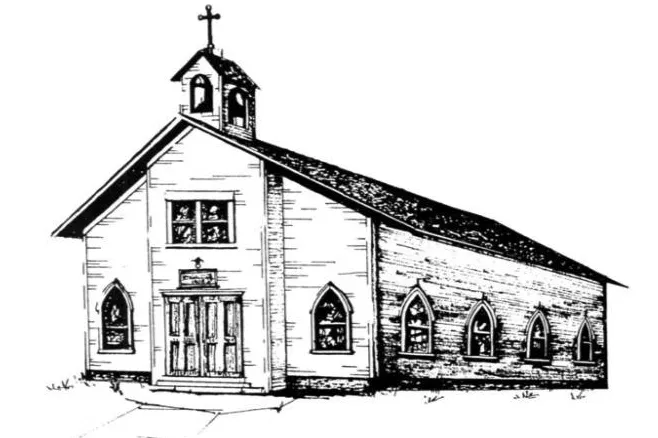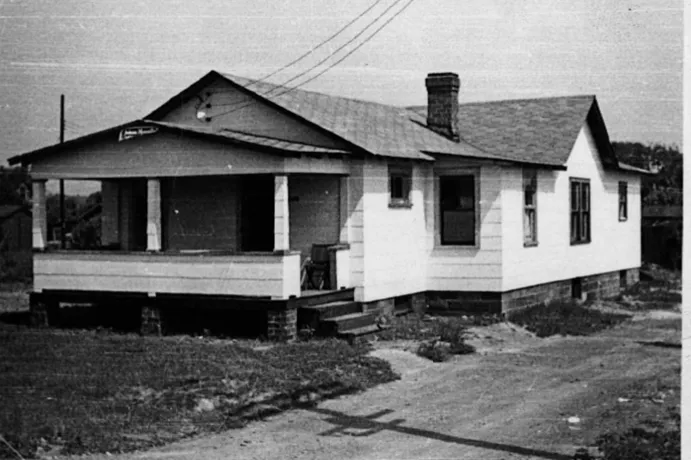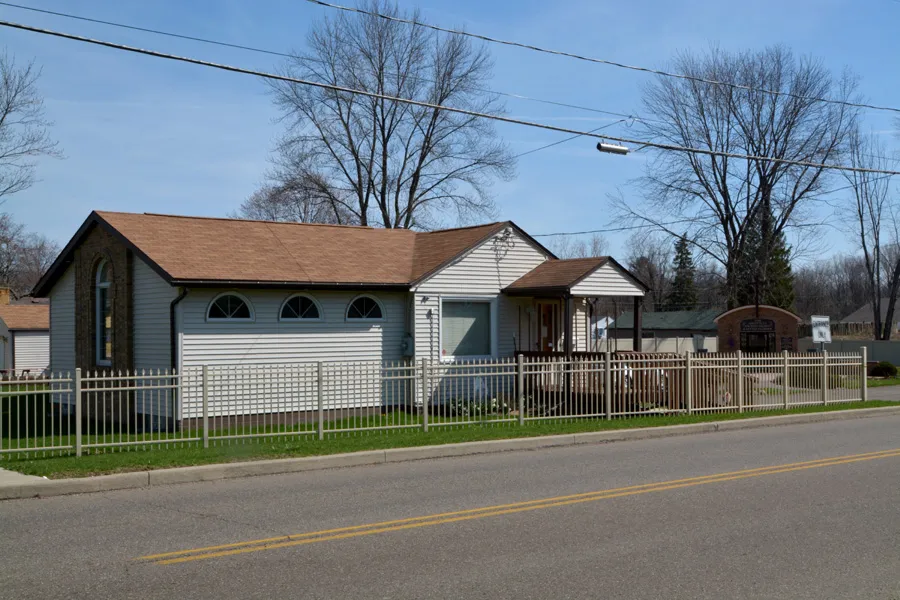
St. Louis, Mo., Apr 20, 2023 / 11:18 am (CNA).
Canton, Ohio, was a rough town in the 1920s. The Mafia ran the show, and crime was rampant. Children who grew up there faced a host of challenges almost unimaginable to many in the United States today — challenges that made childhood there far from typical.
It was into this environment that Rita Rizzo was born 100 years ago, on April 20, 1923. She was raised an only child in a poor household, mainly by a single mother, and fought through numerous physical ailments while still a young woman. She would ultimately defy her difficult upbringing by giving her life to Christ as a religious sister, taking the name Mother Mary Angelica of the Annunciation — better known as “Mother Angelica.” She would later go on to found the largest religious media network in the world — the Eternal Word Television Network (EWTN). EWTN is the parent company of CNA.
Today, the Mother Angelica Museum offers a self-guided tour of some of the notable places in Canton associated with her life and attracts pilgrims from around the country. Sadly, many of the most notable places from Mother Angelica’s early childhood no longer exist — her childhood home, along with the rest of the neighborhood, fell to the march of urban progress and was leveled for a highway. But many of the most formative places from her upbringing still exist.
Barbara Gaskell, director of the Mother Angelica Museum in Canton, spoke with CNA about how the places in Mother Angelica’s hometown shaped her and about the legacy she left behind. (Many of the additional historical details come from Raymond Arroyo’s definitive biography, “Mother Angelica.”)
“She’s one of us. What I would always tell people at the end of the tour was, ‘She’s a nobody from nowhere. But she said yes to Jesus Christ. And he, through her, completely changed the world — literally,’” Gaskell said.
Her neighborhood
Rita Rizzo was born — weighing a hefty 12 pounds, no less — in the home of her grandparents, Mary and Anthony Gianfrancesco, at 1029 Liberty Ave. in Canton. Her grandfather owned a saloon, which was attached to the house. Rita and her mother, Mae, lived with them for most of Rita’s childhood, until 1933, when they moved into a series of apartments.

To say that Rita grew up in a rough neighborhood would be an understatement. In the 1920s, heavily Italian southeast Canton was essentially ruled by the Mafia, especially a group called the Black Hand, which had its roots back in Sicily. Rita’s neighborhood was close to the “red light” district of Canton, where prostitution was common.
“The Mafia had a grip on the city. And the Black Hand, which is a part of the Mafia, really ran that whole neighborhood there,” Gaskell told CNA. “And it was a tough neighborhood, and the editor of the Canton newspaper [Don Mellett] wrote articles about the crime and the Mafia in the area … and about six months later, he was assassinated in his garage.”
The neighborhood was tight-knit and very ethnically Italian, but Rita also remembered meeting and befriending a wide range of people, including many of the neighborhood’s Black residents. Her grandfather, a businessman, also owned several homes in the local area, which he would rent out to Italian immigrants. His saloon provided a place for them to gather, speak in their native tongue, and meet people in the community. Gianfranscesco later suffered a stroke, leaving him disabled.
Rita’s mother set up a dry cleaning shop next door to the saloon for a time as a means of supporting herself after her husband, John, abandoned the family. Mae, who later divorced John, set up a number of entrepreneurial efforts over the years to make ends meet, several of which were run out of the Gianfranscesco home.
Although the house where Mother Angelica grew up — and indeed the entire neighborhood — no longer exists, Gaskell said she would point out the spot where Rita’s house was, near the highway exit ramp, to visitors on this virtual tour.
St. Anthony’s Church and School
The original St. Anthony’s Church, built in 1908, was located at 918 Liberty Ave., just a few blocks away from Rita’s childhood home. When Rita was baptized there, her mother took her to a side altar that housed a statue of Our Lady of Sorrows, dedicating her daughter to Mary under that title.
St. Anthony’s was an important center for the Italian community in the neighborhood, as parishes tended to be much more ethnically segregated back then than they are today. Rita’s mother found community and comfort at the parish and helped to organize events there. The location proved to be an enormous challenge, however, and the parish priest, Father Joseph Riccardi, sought to move the parish several blocks to the east to a better part of town.

As Mother Angelica would later tell it, this plan angered the Mafia — they preferred to have the church in “their” neighborhood to lend the area, and their shady businesses, credibility. Mafia members would even bury their bootlegged liquor in the schoolyard, Mother later said, a practice that the priest wanted no part of. After waging a legal fight to allow the new church to be built in a different location, Riccardi prevailed, and the new church opened in 1927. Two years later, when Rita was 6 years old, Riccardi was shot to death in the church — widely believed to be a Mafia hit.
“They kept the bullet holes there [in the church] up until about 10 years ago,” Gaskell noted.
Mother Angelica spoke in later years of not getting along well with the nuns at St. Anthony’s School. In those days, being the child of a divorcee carried with it a deep stigma. Mae eventually pulled Rita out of St. Anthony’s.
“So [Mother Angelica] was really formed in the life of suffering to start with,” Gaskell said.
St. Anthony’s merged with another parish in 2011 to form St. Anthony’s All Saints.
McKinley High School
Rita attended McKinley High School, named after arguably the town’s most famous son, President William McKinley. She was a loner and her grades weren’t good, but things began to turn around when she was invited to become a majorette in the school’s marching band. Friends remember that role as bringing out a fun and outgoing side of her, but the pain of Rita’s home life and upbringing — especially with her mother always in dire straits — remained a source of great hardship.
“[W]hen I came home from school, I never knew if I would find her dead or alive. I couldn’t study or concentrate,” Mother Angelica later recalled.

The former McKinley High School building is now a medical center in Canton.

Timken Roller Bearings
When the onset of World War II brought a lot of jobs to the steel town of Canton, Rita secured work at the Timken Roller Bearing Company in early 1942, working as a secretary to the company’s vice president for advertising.
The company is still in business and is still headquartered in North Canton, Ohio.

The home of Rhoda Wise
When she was just 18, Rita was beset by a serious and debilitating stomach ailment. Finding little relief from doctors, Rita’s mother, in desperation, took her to the home of Rhoda Wise, a local woman who had a reputation as a healer.

Wise, who had converted to Catholicism after being introduced to the rosary, suffered greatly for years under her own serious medical problems, including a permanently injured foot and a 39-pound ovarian cyst first removed in 1932. Wise claimed she was completely healed of her ailments after receiving a visit from Jesus in her home. During Wise’s life, some 300–500 people a week came to her home seeking help, and many additional healings were reported.
One of those healings was of the skeptical Rita, who at the time was “so engrossed in survival that religion did not affect me,” she later admitted. Wise advised praying a novena to St. Therese, which Rita did. After doing so, she says her stomach ailment, which had caused her suffering for years, was healed overnight. She spent a lot of time over the next few years volunteering at the house and learning from Rhoda.
“That was the absolute turning point in her life. Completely changed her life,” Gaskell said.
“She started learning about the faith. She started volunteering at the Rhoda Wise home, helping with all the pilgrims because they were having thousands of pilgrims coming through there … her spirituality, I believe, was formed through Rhoda Wise. But see, Rhoda was a woman of suffering, right? So the two of them, they had so much in common, that bond of suffering.”
Rhoda Wise’s cause for sainthood has been opened, and she is currently a Servant of God. Her home remains, having been willed to Mother Angelica and EWTN and later deeded to the Rhoda Wise Shrine. Today, the Rhoda Wise House includes exhibits and a prayer grotto.

Sancta Clara Monastery
After her religious awakening, Rita grew in piety and fervor for her faith and perceived in prayer one day before the statue of Our Lady of Sorrows that she was called to a religious vocation. The idea was not supported by her mother, but Rita was determined to follow her call and entered a contemplative Franciscan community in Cleveland when she was 21 years old. It was there that Rita became Sister Mary Angelica of the Annunciation.
Later, Sister Angelica was given the opportunity to return to her hometown.
“She was sent to the new monastery here. There was an older couple that had a mansion that they donated to the diocese; they gave it to the Poor Clares, and they turned it into a monastery,” Gaskell explained. “And so she was sent here as one of the original nuns, which was great because she was back in her hometown.”
Gaskell said Wise, as well as her family, came to Sister Angelica’s profession. “I think everybody in her family went back to church after she became a nun,” she said.
It was at Sancta Clara that Sister Angelica not only grew in devotion and holiness but also honed her entrepreneurial skills by acting as foreman for many of the monastery’s architectural projects. She started a fishing lure business to support the monastery financially.
Later, Sister Angelica would promise God to build a new monastery in the South if she were healed of problems with her legs, which had come about after an accident with a floor scrubbing machine.
“She wanted to go down there to pray for all the racial tension, all the problems in the South. And he did let her walk again, but it was very difficult. She had to have braces; she was in pain pretty much for the rest of her life,” Gaskell said.
Finally, in 1961, Sister Angelica received permission to found a new monastery in Alabama, Our Lady of the Angels.
The Sancta Clara Monastery still exists today with a community of just over a dozen sisters.


If you value the news and views Catholic World Report provides, please consider donating to support our efforts. Your contribution will help us continue to make CWR available to all readers worldwide for free, without a subscription. Thank you for your generosity!
Click here for more information on donating to CWR. Click here to sign up for our newsletter.





Mother Angelica – an inspiring legend.